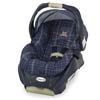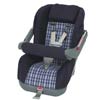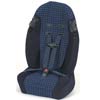Child Safety Seat Law
| Carrier Type | Description | Photo |
|---|---|---|
| Infant Carrier | Designed for children less than 1 year of age and less than 20 pounds. |  |
| Reversible Child Safety Seat | Designed for children less than 1 year of age and less than 20 pounds rear facing. Can also be used as forward facing for children over 1 year of age and up to manufacturers weight limit. |  |
| High Back Booster | Generally designed for children 5 years of age and older. |  |
All children in a vehicle that are younger than 8 years old must be in a child safety seat or booster seat unless they are taller than 4 feet, 9 inches tall. Since last September, officers have been issuing warnings to drivers who don’t buckle up children younger than 8, in a child safety seat or booster seat. Beginning June 1, officers can ticket parents who do not secure their children in child safety seats or booster seats as required by law. Fines for noncompliance range from $25 to $250, plus court costs.
Example:
- If the child is 7 years of age and 4 feet 10 inches tall, they are not required to be in a child safety seat.
- If the child is 8 years of age and 4 feet 7 inches tall, it is recommended but not required by law that the child be secured by child safety seat.
The reason for this change in the law is that car manufactures design their safety belts for persons who are 4 feet 9 inches or taller. The age was created because the average height of an 8 year old child is 4 feet 9 inches. The shoulder strap of a seatbelt usually crosses the neck of a child who is under 4 feet 9 inches. In using the child safety seat, this will help prevent serious injury by raising the child to fit properly with the shoulder strap.
Note: Always consult manufacturers instructions for proper height, weight and age on any car seat you purchase.

